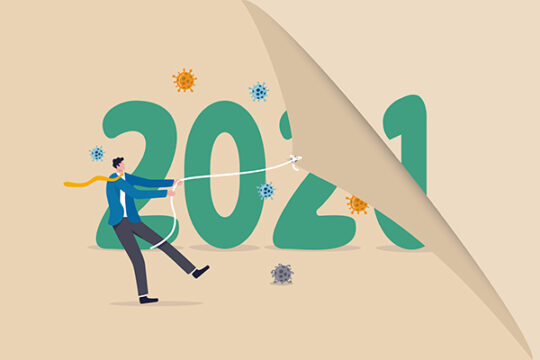
January may seem like seven years ago, but 2020 actually began like any other year in the Dangerous Goods galaxy. We all know what’s happened since then.
The COVID-19 pandemic has, of course, impacted every sector of the global economy. From a hazmat transport perspective, three major trends emerged:
- Regulatory bodies overseeing Dangerous Goods transport showed remarkable wisdom and flexibility in helping organizations cope with the crisis.
- The world’s supply chain was revealed to be incredibly resilient, preserving economic strength during the gravest health challenge in decades.
- Both public and private sectors geared up for the monumental cold chain logistics challenge of transporting COVID-19 vaccines.
Here’s a look back at some of the biggest developments in this unprecedented year.
Regulatory wisdom and flexibility
No one saw COVID-19 coming, but once it was upon us the Dangerous Goods industry was quick to react. Our regulatory bodies were wise enough to recognize that rules created for normal times had to be relaxed or adapted to a world gripped by pandemic.
The most obvious move in this regard was the quick action by PHMSA to facilitate the transport of hand sanitizer. In the earliest days of the pandemic, with supplies running low and demand climbing, distillers of alcoholic beverages eagerly switched over some of their production to make sanitizer—but many had no experience with shipping Class 3 Flammable Liquids.
PHMSA responded quickly, with an April 2 guidance on domestic ground shipment of non-bulk quantities of alcohol-based hand sanitizers that offered some relaxation of the typical requirements and specified certain alternative measures. Without that guidance, thousands of health care facilities might have run out of hand sanitizer just as COVID-19 cases began to surge nationwide.
(These April exemptions expired in October, but were recently reinstated in limited circumstance with COVID-19 cases surging again.)
Another area needing immediate attention was training. Social distancing protocols made live training all but impossible, so in late March PHMSA relaxed enforcement action in reference to recurrent training requirements for 90 days. (This relief was later extended through October.)
Training is essential, of course, but PHMSA wisely recognized that enforcing such requirements during a global pandemic would be highly counterproductive.
An amazingly resilient—and safe—supply chain
Remember when everyone was panicking about toilet paper? We can laugh about it now, because our supply chains stayed up and running from the earliest days of the pandemic, so shortages of important items never became a major problem. Heading into the holidays, e-commerce volume is destroying existing records.
Supply chains were able to continue functioning because millions of essential workers continued to work on the front lines instead of sheltering safely at home.
Best of all, the Dangerous Goods supply chain had its safest year in nearly a decade. Through December 14, PHMSA had reported 13275 hazmat incidents—down 41% from 2019. Injuries were down even more, from 182 in 2019 to just 51 this year. While that’s still 51 too many, we’re delighted to see this 72% drop.
While overall volume was down, it wasn’t down that much. This was a much safer year in hazmat transport.
DG implications for COVID-19 vaccines
Maybe you’ve heard: COVID-19 vaccines have been approved and will soon be available nearly everywhere (though not to everyone).
While the vaccines themselves are not classified as Dangerous Goods, they need to be manufactured, transported, stored and kept at ultra-cold or even cryogenic temperatures to remain effective. That means dry ice or liquid nitrogen will be involved—and both are governed by Dangerous Goods restrictions that will impact how vaccines are transported.
Labelmaster Senior Manager Jay Johnson discusses these restrictions in both a podcast and a blog post, and is planning a webinar in January.
A quick 2021 DG regulatory preview
Two 2020 developments should have significant impact in 2021.
Starting January 1, smaller lithium battery marks will be compliant—100 mm X 100 mm and 100 mm X 70 mm. These marks serve the exact same function as their larger cousins, but they’re just a bit smaller—and that little bit can actually make a big difference for many shippers.
PHMSA’s publication of HM-219C will have a broader impact. Its most significant rulemaking in some time is intended to reduce regulatory burdens. It harmonizes more than 1000 entries in the 49 CFR with international regulations, and contains numerous other actions that make the hazardous materials regulations less complex while also increasing safety of transport. Here’s a summary of the rule’s major elements.
(For a detailed, weekly recap of new developments from every significant regulatory body, read Labelmaster’s DG Digest every Monday. And if you ever have questions about Dangerous Goods regulations, please call our experts on the hazmat hotline.)
Everyone in the Dangerous Goods galaxy hopes for a more “normal” 2021. Let’s stay safe over the holidays and make it happen next year!
Make sure your shipments are safe and in complete compliance with a full line of solutions from Labelmaster—a full-service provider of goods and services for hazardous materials and Dangerous Goods professionals, shippers, transport operators and EH&S providers.


